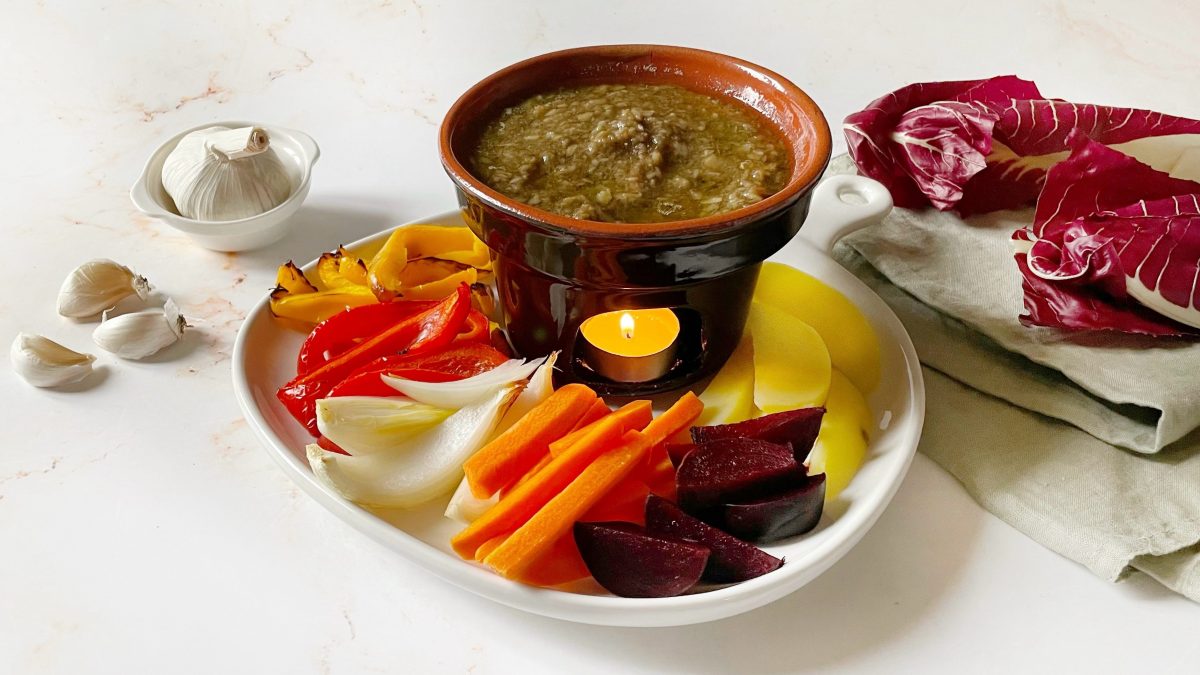
Authentic Bagna Cauda, which literally translates to "hot sauce", is a typical Piedmontese recipe made with anchovies, garlic and oil. With an intense and decisive flavor, it is used as a sauce for both raw and cooked vegetables.
It is a convivial dish, typically eaten as a single dish or appetizer and served in the dian, a terracotta pan placed on a clay warmer filled with embers, called s-cionfetta, which keeps it at the right temperature. Tradition dictates that it should be placed in the center of the table, so as to allow all diners to dip vegetables in the sauce. Alternatively, it can be served in special fujot, individual clay or copper containers equipped with a small burner.
Bagna cauda is served with seasonal vegetables: Nizza Monferrato cardoon, quartered spring onions, raw cabbage and Jerusalem artichokes, but also boiled potatoes and beets, baked onions and fried pumpkin.
What is Bagna Cauda? History and Origins
It is thought that bagna cauda (pronounced as BAHN-yah KOW-dah) was born in the late Middle Ages, a period in which it seems it was prepared by winemakers to celebrate the tapping of the new wine, but this is only a hypothesis: the recipe as we know it was reported only in 1875 by Roberto Sacchetti, a writer and journalist from Turin. However, it seems that the salt routes that connected Piedmont with the French salt mines were important for the birth of the recipe: in fact, through these routes, traders stocked up on the main ingredient of the dish, namely anchovies.
Considered a poor man's dish, the prerogative of peasants, bagna cauda was once even considered "inappropriate" by the wealthier classes due to its strong garlic smell; today, however, it is a true symbolic dish of Piedmont, so much so that a celebration has even been dedicated to it: every year, between the end of November and the beginning of December, Bagna Cauda Day is celebrated in Asti, an event dedicated exclusively to this preparation.
Pro Tips for The Best Authentic Bagna Cauda
- For the best flavor, opt for fresh, high-quality anchovies, garlic, and olive oil. The anchovies should be packed in salt or oil, and the garlic should be fresh to give the dish its signature depth. Extra virgin olive oil is a must for the rich, smooth base of the sauce.
- When cooking the garlic, make sure to do it slowly and gently over low heat. This allows the garlic to soften and mellow out, without burning, which would impart a bitter taste. Slow cooking is key to achieving the perfect balance of sweetness and richness in the bagna cauda.
- The anchovies need to be melted into the oil. Add them slowly and stir until they dissolve completely, creating a smooth, savory base. Don’t rush this process, as it’s essential for developing the full, umami-packed flavor of the sauce.
- The consistency of bagna cauda can be adjusted depending on your preference. If you prefer a thicker sauce, let it cook down a little more. If it becomes too thick, you can add a splash of warm water or more olive oil to thin it out to your liking.
- Anchovies can be quite salty, so be careful when adding additional salt to the sauce. Taste as you go, and adjust accordingly to avoid making the dish too salty.
What Does Bagna Cauda Taste Like?
Bagna cauda has a rich, savory, and umami-packed flavor profile. The sauce combines the deep saltiness of anchovies with the mellow sweetness of slow-cooked garlic, all balanced by the smoothness of olive oil. The result is a warm, garlicky dip with a slight tanginess from the anchovies, offering a comforting, bold, and aromatic taste. When served with fresh vegetables, the sauce enhances their natural flavors, creating a delightful contrast between the creamy, garlicky richness and the crisp, fresh crunch of the veggies.
Is Bagna Cauda Healthy?
Bagna cauda can be considered relatively healthy when enjoyed in moderation. The sauce is made with olive oil, which provides heart-healthy fats, and garlic, which is known for its potential health benefits like boosting immunity. Anchovies offer protein and omega-3 fatty acids, which are beneficial for heart health. However, the dish can be high in sodium due to the anchovies, so it’s best to consume it with fresh, crisp vegetables to balance out the richness and keep it a nutritious choice.
How To Serve Bagna Cauda
Bagna cauda is best served warm, so make sure to keep it at a low simmer while eating, especially if you are serving it family-style. This allows everyone to dip fresh vegetables into the sauce as it remains flavorful and comforting throughout the meal.
Traditional vegetables to serve with bagna cauda include raw or lightly blanched vegetables such as fennel, celery, red peppers, and cardoon (a thistle-like plant). These vegetables provide a lovely contrast to the rich, garlicky sauce. You can also serve it with boiled potatoes or crusty bread for added texture.
Can I Make Bagna Cauda Ahead of Time?
Yes, bagna cauda can be made ahead of time! In fact, it often tastes even better after the flavors have had time to meld. To make it ahead, simply prepare the sauce as directed, let it cool, and store it in an airtight container in the refrigerator. When you're ready to serve, gently reheat the sauce over low heat, stirring occasionally. You may need to add a bit more olive oil or water if it thickens during storage. Serve warm with your choice of fresh vegetables for a delicious, make-ahead dish!
Does It Freeze Well?
Bagna cauda doesn't freeze very well due to its olive oil base and the delicate nature of the garlic and anchovies. Freezing can cause the sauce to separate and affect its texture, making it less smooth when reheated. For the best taste and texture, it's recommended to enjoy bagna cauda fresh or store it in the refrigerator for a few days.
How to Store Any Leftovers
To store any leftover bagna cauda, allow it to cool to room temperature first. Then, transfer the sauce to an airtight container and refrigerate it. It can be kept in the fridge for up to 3–4 days. When you're ready to enjoy it again, gently reheat the sauce over low heat, adding a little more olive oil or water if needed to restore its smooth texture. Always store it separately from the vegetables you served it with to maintain freshness.
Ingredients
How to Make Authentic Bagna Cauda
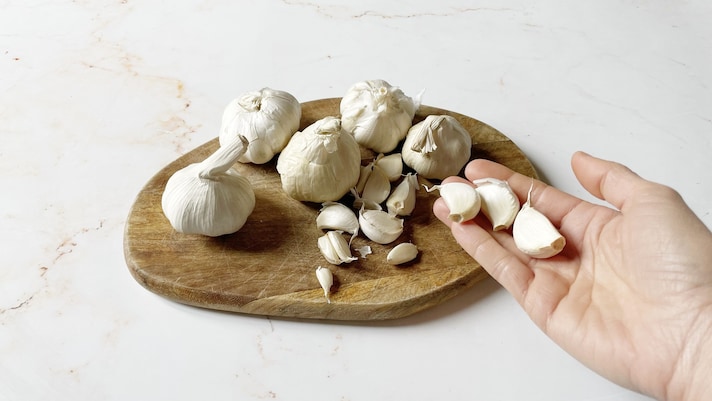
To prepare the bagna cauda, start with the garlic: remove the cloves from the heads, peel them, remove the core and cut them into thin slices.
To prepare the bagna cauda, start with the garlic: remove the cloves from the heads, peel them, remove the core and cut them into thin slices.
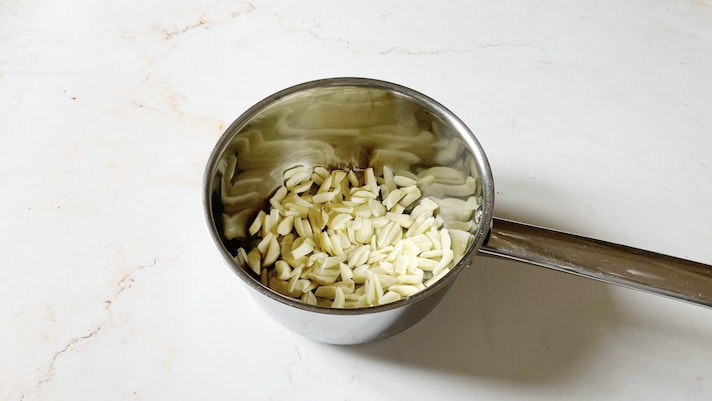
Then transfer them into a saucepan and set them aside.
Then transfer them into a saucepan and set them aside.

Place the salted anchovies in a container, cover them with cold water and leave them to soak for at least 2 hours, changing the water often. After the indicated time, drain them, clean them by removing the innards and the internal bone and rinse them under cold running water. After drying them carefully with absorbent paper, distribute them in a baking dish.
Place the salted anchovies in a container, cover them with cold water and leave them to soak for at least 2 hours, changing the water often. After the indicated time, drain them, clean them by removing the innards and the internal bone and rinse them under cold running water. After drying them carefully with absorbent paper, distribute them in a baking dish.
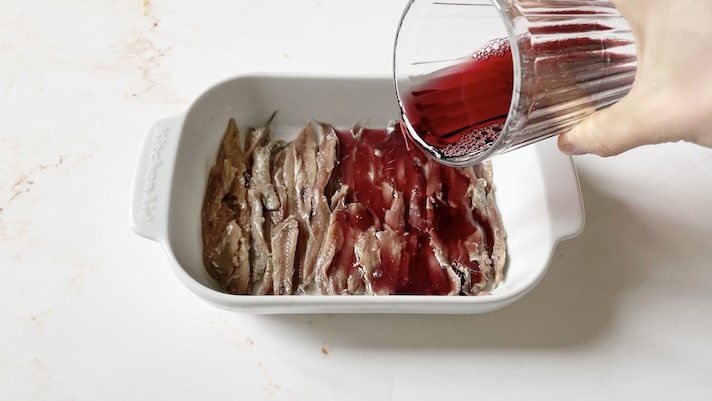
Now pour the red wine, mix very delicately and let them flavor for a few minutes.
Now pour the red wine, mix very delicately and let them flavor for a few minutes.
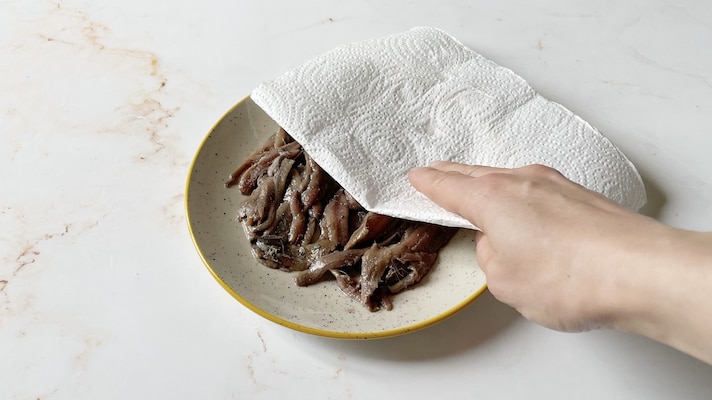
Drain the anchovies from the wine, arrange them on a plate and dry them again with a sheet of absorbent paper.
Drain the anchovies from the wine, arrange them on a plate and dry them again with a sheet of absorbent paper.
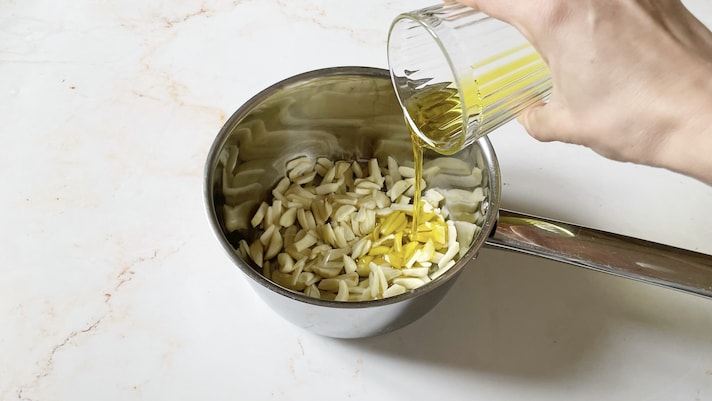
Then take the garlic and pour 100 milliliters of oil into the saucepan.
Then take the garlic and pour 100 milliliters of oil into the saucepan.
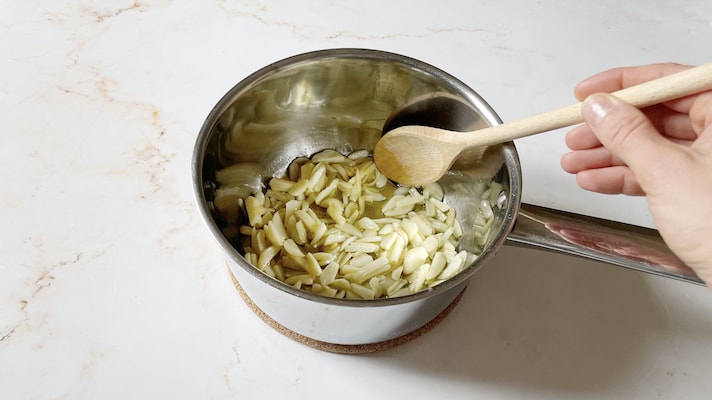
Cook for 5 minutes on low heat.
Cook for 5 minutes on low heat.
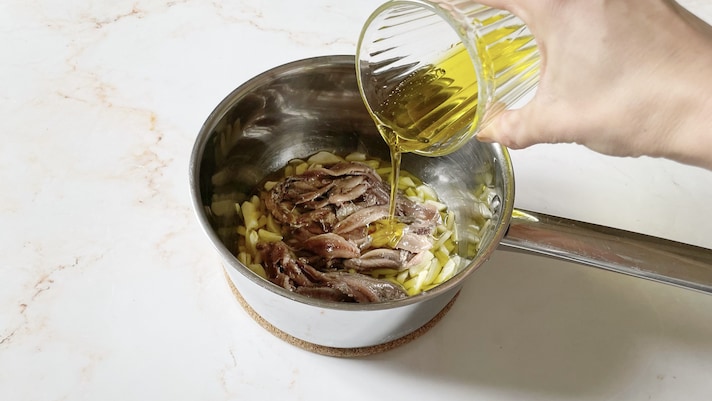
Then add the anchovies and the remaining oil.
Then add the anchovies and the remaining oil.
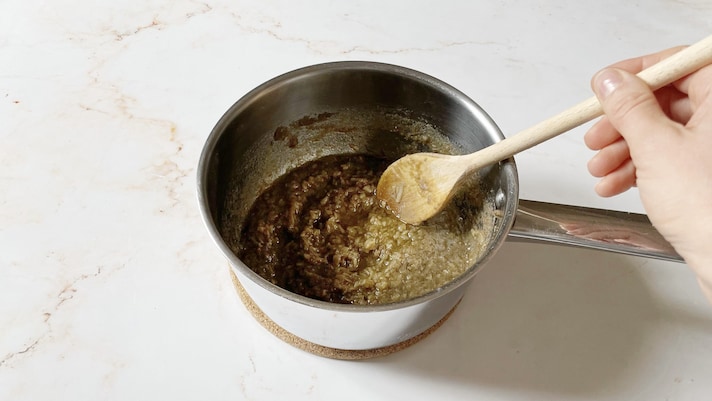
Cook over low heat for 30 minutes, until the anchovies are flaked and you have obtained a cream.
Cook over low heat for 30 minutes, until the anchovies are flaked and you have obtained a cream.
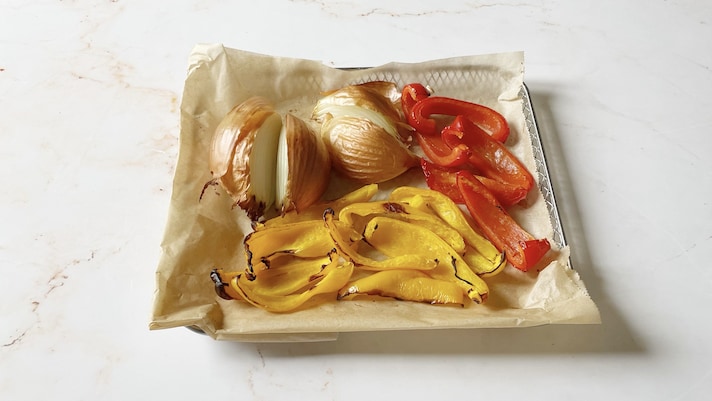
Finally, dedicate yourself to the vegetables. Clean the peppers and cut them into strips, divide the onion in half and arrange the vegetables on a baking tray, lined with baking paper, then cook in a fan oven at 360°F/180°C for 20 minutes.
Finally, dedicate yourself to the vegetables. Clean the peppers and cut them into strips, divide the onion in half and arrange the vegetables on a baking tray, lined with baking paper, then cook in a fan oven at 360°F/180°C for 20 minutes.
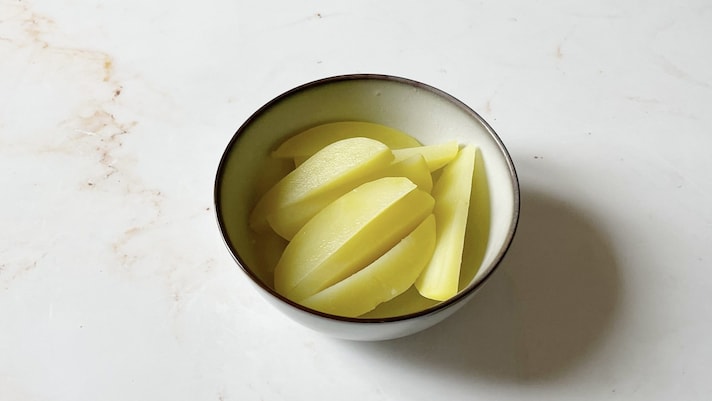
Meanwhile, boil the potatoes, then drain them, peel them and cut them into wedges. Also cut the pre-cooked carrots and beetroot into strips.
Meanwhile, boil the potatoes, then drain them, peel them and cut them into wedges. Also cut the pre-cooked carrots and beetroot into strips.
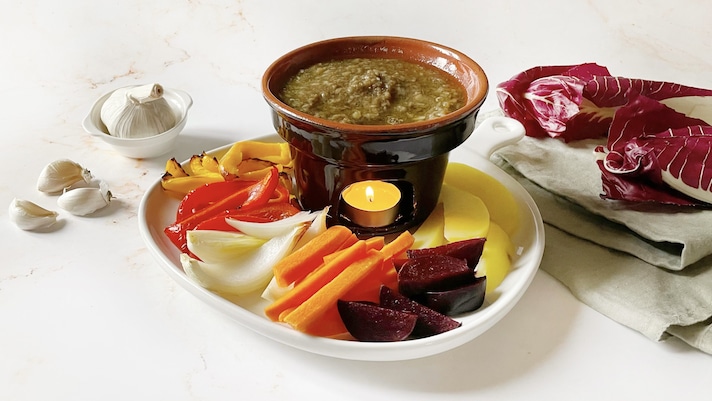
The bagna cauda is ready: arrange the vegetables on a serving dish, pour the sauce into the typical fujot or a small bowl and enjoy it immediately, perhaps accompanying it with a good glass of red wine such as Barbera d'Asti.
The bagna cauda is ready: arrange the vegetables on a serving dish, pour the sauce into the typical fujot or a small bowl and enjoy it immediately, perhaps accompanying it with a good glass of red wine such as Barbera d'Asti.
;Resize,width=767;)
